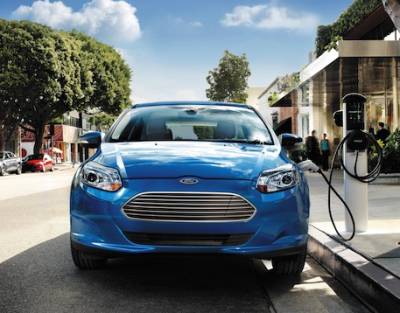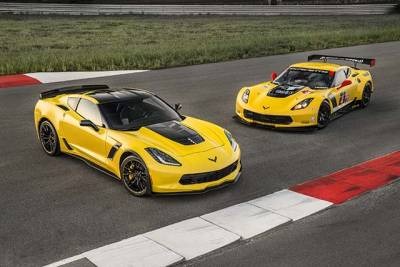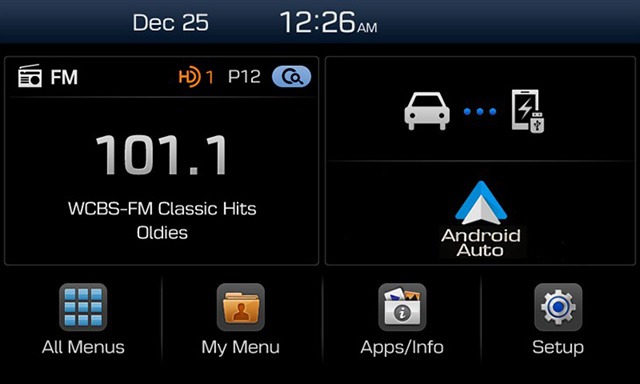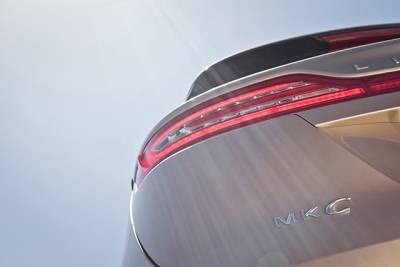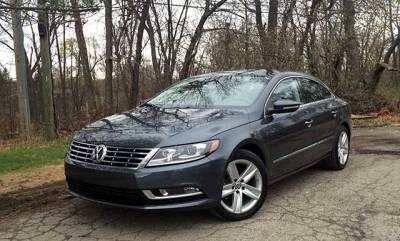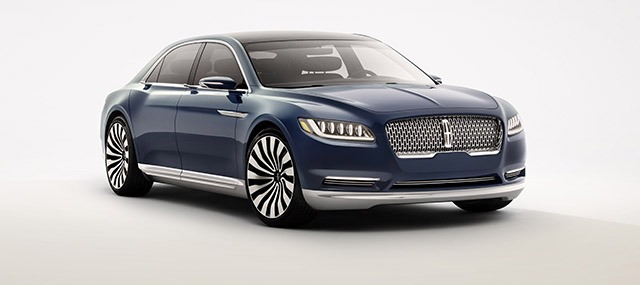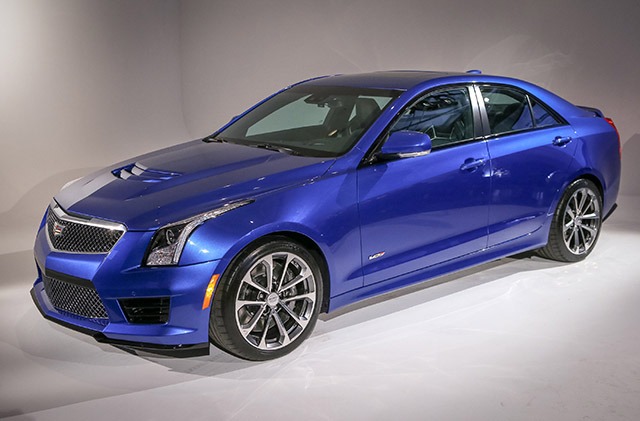-
Posts
32,884 -
Joined
-
Last visited
-
Days Won
5
Content Type
Forums
Articles
Garage
Gallery
Events
Store
Collections
Everything posted by William Maley
-

Ford Cuts A Shift At Wayne Assembly Due To Slow Compact Sales
William Maley posted an article in Ford
Ford announced this week that it will be cutting a shift at its Michigan Assembly Plant in Wayne, MI - where the Focus and C-Max are built - due to slumping sales. Ford says the cut will affect a total of 700 workers - 673 hourly workers and 27 salaried employees. "Ford will be working to redeploy affected hourly employees and they will be considered first for southeast Michigan opportunities as they become available," Ford said in statement to The Detroit News. Salaried employees will be moved to other Ford facilities. Sales of the Ford Focus dropped 14.5 percent last month, despite a refreshed model and a price cut on the electric model. The C-Max was hit worse with a sales drop of 22.9 percent. Automotive News reports there had been rumors flying around for weeks about Ford cutting the third shift. When asked last week about this, Ford said they had now changes in store for the plant. Coincidentally, this announcement comes a few days after Ford announced a $2.5 billion investment in new transmission and engine plants in Mexico. Source: Automotive News (Subscription Required), The Detroit News -
Ford announced this week that it will be cutting a shift at its Michigan Assembly Plant in Wayne, MI - where the Focus and C-Max are built - due to slumping sales. Ford says the cut will affect a total of 700 workers - 673 hourly workers and 27 salaried employees. "Ford will be working to redeploy affected hourly employees and they will be considered first for southeast Michigan opportunities as they become available," Ford said in statement to The Detroit News. Salaried employees will be moved to other Ford facilities. Sales of the Ford Focus dropped 14.5 percent last month, despite a refreshed model and a price cut on the electric model. The C-Max was hit worse with a sales drop of 22.9 percent. Automotive News reports there had been rumors flying around for weeks about Ford cutting the third shift. When asked last week about this, Ford said they had now changes in store for the plant. Coincidentally, this announcement comes a few days after Ford announced a $2.5 billion investment in new transmission and engine plants in Mexico. Source: Automotive News (Subscription Required), The Detroit News View full article
-

Chevrolet News:Chevrolet Debuts 2016 Corvette Z06 C7.R Edition
William Maley replied to William Maley's topic in Chevrolet
Nothing on price and yes.- 5 replies
-
- 2016
- C7.R Edition
- (and 5 more)
-
The Corvette has a long history of excelling in endurance racing, and the C7.R looks to continue that. To celebrate the legacy, Chevrolet has announced a special edition Corvette Z06 which brings some of C7.R race car to the road. The 2016 Corvette Z06 C7.R Edition comes in yellow or black and boasts a fair amount of unpainted carbon fiber (including the material on the hood), along with grilles painted in Spectra Gray Metallic. A set of black wheels with Corvette Racing caps come wrapped in Michelin Pilot Super Sport Cup 2 tires. Inside are a set of Competition Sport Seats that are upholstered in Jet Black leather. Suede lines the steering wheel, gearshift, instrument panel, and doors. Being a Z06, the C7.R Edition packs the supercharged V8 producing 650 horsepower found in the standard Z06. You also get the Z07 performance package which boasts carbon-ceramic brakes and adjustable aero elements. Chevrolet plans on building 500 C7.R Edition Corvettes which will go on sale later this year. No word on price. Source: Chevrolet Press Release is on Page 2 BOWLING GREEN, Ky. – Chevrolet today introduced the 2016 Corvette Z06 C7.R Edition – a road-going, track-capable homage to the Corvette Racing C7.R racecars. It’s offered in Corvette Racing’s signature yellow livery – or black – with coordinated exterior and interior accents. Only 500 examples of the C7.R Edition will be built and all will include the Z07 Performance Package with carbon ceramic brakes, as well as a specially serialized vehicle identification number. They go on sale later this year. “Corvette Racing’s legacy and technology were significant influences on the development of the Corvette Z06 and the new C7.R Edition honors the direct link between the racecar and the production model,” said Harlan Charles, Corvette product and marketing manager. “It also advances Chevrolet’s plan to offer special-edition models that offer a unique, personal ownership experiences, which become important parts of Corvette’s legacy.” Here is a complete list of content and unique features for the 2016 Corvette Z06 C7.R Edition: Offered on coupe and convertible models with 3LZ trim Available in Corvette Racing Yellow Tintcoat (new for 2016) or Black exterior colors C7.R Edition graphics package Z07 Performance Package with Brembo carbon ceramic brakes and Michelin PS Cup 2 tires Yellow brake calipers Black wheels with yellow accent strip and Corvette Racing-logo center caps Visible carbon fiber ground effects package New visible carbon fiber hood section Grilles and vents finished in Spectra Gray Metallic Jet Black leather interior with sueded microfiber accents on the instrument panel and doors Sueded microfiber-trimmed Competition Sport Seat, steering wheel and shifter Yellow contrast stitching throughout the interior Carbon fiber interior trim package (high-gloss) Corvette Racing sill plates Numbered C7.R Edition interior plaque showing the build number, starting with VIN 700001 Special indoor car cover with C7.R graphics. The Z07 Performance Package includes Brembo carbon ceramic-matrix brake rotors that improve braking performance and contribute to greater handling through reduced un-sprung weight. The Z07 package also includes adjustable front and rear aero components for unprecedented aerodynamic downforce and Michelin Pilot Super Sport Cup 2 tires for enhanced grip. “The Z07 Performance Package enhances overall performance to make the Corvette Z06 one of the most track-capable cars you can buy off the dealership floor and still drive it to work every day,” said Charles. “Combined with the 650-horsepower supercharged LT4 engine, true aerodynamic downforce and performance technologies such as Magnetic Ride Control, Performance Traction Management and an electronic limited slip differential, the Corvette Z06 C7.R Edition offers capability matched only by an elite fraternity of the world’s supercars and special-edition exclusivity that is sure to make it an instant collector’s item.” View full article
- 5 replies
-
- 2016
- C7.R Edition
- (and 5 more)
-
The Corvette has a long history of excelling in endurance racing, and the C7.R looks to continue that. To celebrate the legacy, Chevrolet has announced a special edition Corvette Z06 which brings some of C7.R race car to the road. The 2016 Corvette Z06 C7.R Edition comes in yellow or black and boasts a fair amount of unpainted carbon fiber (including the material on the hood), along with grilles painted in Spectra Gray Metallic. A set of black wheels with Corvette Racing caps come wrapped in Michelin Pilot Super Sport Cup 2 tires. Inside are a set of Competition Sport Seats that are upholstered in Jet Black leather. Suede lines the steering wheel, gearshift, instrument panel, and doors. Being a Z06, the C7.R Edition packs the supercharged V8 producing 650 horsepower found in the standard Z06. You also get the Z07 performance package which boasts carbon-ceramic brakes and adjustable aero elements. Chevrolet plans on building 500 C7.R Edition Corvettes which will go on sale later this year. No word on price. Source: Chevrolet Press Release is on Page 2 BOWLING GREEN, Ky. – Chevrolet today introduced the 2016 Corvette Z06 C7.R Edition – a road-going, track-capable homage to the Corvette Racing C7.R racecars. It’s offered in Corvette Racing’s signature yellow livery – or black – with coordinated exterior and interior accents. Only 500 examples of the C7.R Edition will be built and all will include the Z07 Performance Package with carbon ceramic brakes, as well as a specially serialized vehicle identification number. They go on sale later this year. “Corvette Racing’s legacy and technology were significant influences on the development of the Corvette Z06 and the new C7.R Edition honors the direct link between the racecar and the production model,” said Harlan Charles, Corvette product and marketing manager. “It also advances Chevrolet’s plan to offer special-edition models that offer a unique, personal ownership experiences, which become important parts of Corvette’s legacy.” Here is a complete list of content and unique features for the 2016 Corvette Z06 C7.R Edition: Offered on coupe and convertible models with 3LZ trim Available in Corvette Racing Yellow Tintcoat (new for 2016) or Black exterior colors C7.R Edition graphics package Z07 Performance Package with Brembo carbon ceramic brakes and Michelin PS Cup 2 tires Yellow brake calipers Black wheels with yellow accent strip and Corvette Racing-logo center caps Visible carbon fiber ground effects package New visible carbon fiber hood section Grilles and vents finished in Spectra Gray Metallic Jet Black leather interior with sueded microfiber accents on the instrument panel and doors Sueded microfiber-trimmed Competition Sport Seat, steering wheel and shifter Yellow contrast stitching throughout the interior Carbon fiber interior trim package (high-gloss) Corvette Racing sill plates Numbered C7.R Edition interior plaque showing the build number, starting with VIN 700001 Special indoor car cover with C7.R graphics. The Z07 Performance Package includes Brembo carbon ceramic-matrix brake rotors that improve braking performance and contribute to greater handling through reduced un-sprung weight. The Z07 package also includes adjustable front and rear aero components for unprecedented aerodynamic downforce and Michelin Pilot Super Sport Cup 2 tires for enhanced grip. “The Z07 Performance Package enhances overall performance to make the Corvette Z06 one of the most track-capable cars you can buy off the dealership floor and still drive it to work every day,” said Charles. “Combined with the 650-horsepower supercharged LT4 engine, true aerodynamic downforce and performance technologies such as Magnetic Ride Control, Performance Traction Management and an electronic limited slip differential, the Corvette Z06 C7.R Edition offers capability matched only by an elite fraternity of the world’s supercars and special-edition exclusivity that is sure to make it an instant collector’s item.”
- 5 comments
-
- 2016
- C7.R Edition
- (and 5 more)
-
A number of OEMs are actually going forward with this idea. Hyundai (their system is what I used for the picture) will be offering Android Auto and Apple CarPlay since they know different people use different phones.
- 2 replies
-
- Controls
- Infotainment
-
(and 4 more)
Tagged with:
-
The past few years in the automotive industry has seen an explosion in technologies - whether its dealing improving the overall safety of a vehicle or figuring out a way to hook up your smartphone. Some of the tech makes the driving experience better, while others don't. So what do consumers think about the new technologies coming into vehicles? J.D. Power decided to find out. In their 2015 US Tech Choice Study, the company asked 5,300 consumers who either bought or leased a new vehicle within the past five years about the technologies that are being put in vehicles. Their results are interesting to say in the least. For example, safety tech is a big item for consumers. 40 percent of those surveyed expressed interest in blind-spot monitoring systems, 33 percent were interested in night vision systems, and 30 percent said they were intrigued by crash mitigation systems, along with backup cameras. Was there technologies that consumers couldn't really care about. Very much so. Only nine percent on consumers wanted gesture controls and further eight percent said they wanted haptic feedback in the touchscreen. J.D. Power also asked consumers about Apple's Carplay and Android Auto, systems that allow you to use phone via the infotainment system. Unsurprisingly, preference for either system came down to what phone you had. Notably, neither system garnered high marks in the survey. "Owners of luxury vehicles tend to own iOS devices,[1] so for many luxury brands, offering Apple CarPlay may be the best option, realizing they may be leaving out a portion of the market. For non-luxury vehicle brands, the ownership of Apple and Android devices is much closer to an equal split. The solution for those brands may be to offer both operating systems and allow customers to select the option best suited for them," said Kristin Kolodge, executive director of driver interaction & HMI research at J.D. Power. Finally, J.D. Power's survey showed that Gen Y is willing to spend for tech. According to the survey results, Gen Y willing to spend an average of $3,703, followed by Gen X with an average of $3,003, and Baby Boomers spending an average of $2,416. Source: J.D. Power Press Release is on Page 2 J.D. POWER 2015 U.S. TECH CHOICE STUDY Consumer Preference for Collision Protection Technologies Paves the Way for Autonomous Driving Apple CarPlay vs. Google Android Auto? It Depends on Your Phone WESTLAKE VILLAGE, Calif.: 22 April 2015 - Three of the top five technologies consumers most prefer in their next vehicle are related to collision protection, according to the J.D. Power 2015 U.S. Tech Choice StudySM released today. Technologies that reduce the overall burden of driving and enhance the safety of the vehicle and its occupants receive the most consumer attention. Among the technologies consumers express most interest in having in their next vehicle are blind spot detection and prevention systems, night vision, and enhanced collision mitigation systems. These findings demonstrate growing customer acceptance towards the concept of the vehicle taking over critical functions such as braking and steering, which are the foundational building blocks leading to the possibility of fully-autonomous driving. The only non-collision protection technologies to crack the top five are camera rearview mirror, which falls into the driving assistance category, and self-healing paint, a comfort and convenience category. The inaugural study uses advanced statistical methodologies to measure preference for and perceived value of future and emerging technologies. A total of 59 advanced vehicle features are examined across six major categories: entertainment and connectivity; comfort and convenience; collision protection; driving assistance; navigation; and energy efficiency. "There is a tremendous interest in collision protection technologies across all generations, which creates opportunities across the market," said Kristin Kolodge, executive director of driver interaction & HMI research at J.D. Power. "In contrast, there is very little interest in energy efficiency technologies such as active shutter grille vents and solar glass roofs. Owners aren't as enthusiastic about having these technologies in their next vehicle because of other efforts automakers are taking to improve fuel economy, as well as relatively low fuel prices at the present time." Apple CarPlay vs. Google Android Auto Smartphones play an increasingly vital role in everyday life, and vehicle technology is beginning to mirror what is offered on those devices, yet Apple CarPlay and Google Android Auto technologies consistently have among the lowest preference scores across all generations. Consumer preferences for Apple CarPlay and Android Auto are uniquely dependent on which smartphone they own. Those who currently own a smartphone that is compatible with one of these technologies would choose the technology compatible with their phone at only a moderate rate, while those with the opposite brand of smartphone will rarely, if ever, choose that technology. For example, Android owners indicate that Apple CarPlay is "unacceptable" nearly twice as often as they indicate that solar glass roof is unacceptable. Similarly, Apple phone owners indicate that Android Auto is "unacceptable" nearly twice as often as solar glass roof. Kolodge noted that "lukewarm interest in these technologies that connect your phone to your vehicle coupled with consumer loyalty to their phone poses a unique challenge for automakers, which could be remedied by knowing their customers' phone preferences." "Owners of luxury vehicles tend to own iOS devices,[1] so for many luxury brands, offering Apple CarPlay may be the best option, realizing they may be leaving out a portion of the market," said Kolodge. "For non-luxury vehicle brands, the ownership of Apple and Android devices is much closer to an equal split. The solution for those brands may be to offer both operating systems and allow customers to select the option best suited for them." Gen Y Willing to Spend Most for Technology Across all generations[2], price is the most important consideration for technology, accounting for 25.2 percent of importance. Gen Y is the least sensitive to technology price and shows a greater willingness to spend on new technologies than the other generations. Gen Y consumers, who have accounted for 27.7 percent of new-vehicle sales thus far in 2015[3]-second only to Boomers at 37.1 percent-are willing to spend an average of $3,703 on technology for their next vehicle. Gen X is willing to spend $3,007, while Boomers, who show the greatest price sensitivity, and Pre-Boomers are willing to spend only $2,416 and $2,067, respectively. Importance of Technology A certainty in the automotive domain is the impact the consumer electronics world has had upon it. From shifting consumer expectations of user interaction, to the rapid pace of technology introduction and importance of keeping software up to date, to the miniaturization and creation of cost-effective solutions for sensors and cameras, "the auto industry is standing on its head to keep technology up to consumers' new standards," said Kolodge. "Those who haven't done so have seen negative feedback from consumers." KEY FINDINGS Full self-driving automation technology, part of the collision protection category, is designed to perform all safety-critical driving functions and monitor roadway conditions. The younger generations (Gen Y and Gen X) have substantially higher preference for the technology than the older generations (Boomer and Pre-Boomer). The Pre-Boomer generation, in contrast, has a greater preference for lower levels of automation, such as traffic jam assist. ŸBlind spot detection and prevention has high preference across the range of vehicle price segments. In contrast, reverse auto braking systems have low preference across the vehicle price segments and preference wanes as vehicle prices increase. ŸAdvanced sensor technologies, such as hand gesture controlled seats, biometric driver sensors or haptic touch screens have low preference. ŸTechnologies in the navigation category have low preference across all vehicle price segments. The 2015 U.S. Tech Choice Study was fielded in January through March 2015 and is based on an online survey of more than 5,300 consumers who purchased/leased a new vehicle in the past five years. View full article
- 2 replies
-
- Controls
- Infotainment
-
(and 4 more)
Tagged with:
-
The past few years in the automotive industry has seen an explosion in technologies - whether its dealing improving the overall safety of a vehicle or figuring out a way to hook up your smartphone. Some of the tech makes the driving experience better, while others don't. So what do consumers think about the new technologies coming into vehicles? J.D. Power decided to find out. In their 2015 US Tech Choice Study, the company asked 5,300 consumers who either bought or leased a new vehicle within the past five years about the technologies that are being put in vehicles. Their results are interesting to say in the least. For example, safety tech is a big item for consumers. 40 percent of those surveyed expressed interest in blind-spot monitoring systems, 33 percent were interested in night vision systems, and 30 percent said they were intrigued by crash mitigation systems, along with backup cameras. Was there technologies that consumers couldn't really care about. Very much so. Only nine percent on consumers wanted gesture controls and further eight percent said they wanted haptic feedback in the touchscreen. J.D. Power also asked consumers about Apple's Carplay and Android Auto, systems that allow you to use phone via the infotainment system. Unsurprisingly, preference for either system came down to what phone you had. Notably, neither system garnered high marks in the survey. "Owners of luxury vehicles tend to own iOS devices,[1] so for many luxury brands, offering Apple CarPlay may be the best option, realizing they may be leaving out a portion of the market. For non-luxury vehicle brands, the ownership of Apple and Android devices is much closer to an equal split. The solution for those brands may be to offer both operating systems and allow customers to select the option best suited for them," said Kristin Kolodge, executive director of driver interaction & HMI research at J.D. Power. Finally, J.D. Power's survey showed that Gen Y is willing to spend for tech. According to the survey results, Gen Y willing to spend an average of $3,703, followed by Gen X with an average of $3,003, and Baby Boomers spending an average of $2,416. Source: J.D. Power Press Release is on Page 2 J.D. POWER 2015 U.S. TECH CHOICE STUDY Consumer Preference for Collision Protection Technologies Paves the Way for Autonomous Driving Apple CarPlay vs. Google Android Auto? It Depends on Your Phone WESTLAKE VILLAGE, Calif.: 22 April 2015 - Three of the top five technologies consumers most prefer in their next vehicle are related to collision protection, according to the J.D. Power 2015 U.S. Tech Choice StudySM released today. Technologies that reduce the overall burden of driving and enhance the safety of the vehicle and its occupants receive the most consumer attention. Among the technologies consumers express most interest in having in their next vehicle are blind spot detection and prevention systems, night vision, and enhanced collision mitigation systems. These findings demonstrate growing customer acceptance towards the concept of the vehicle taking over critical functions such as braking and steering, which are the foundational building blocks leading to the possibility of fully-autonomous driving. The only non-collision protection technologies to crack the top five are camera rearview mirror, which falls into the driving assistance category, and self-healing paint, a comfort and convenience category. The inaugural study uses advanced statistical methodologies to measure preference for and perceived value of future and emerging technologies. A total of 59 advanced vehicle features are examined across six major categories: entertainment and connectivity; comfort and convenience; collision protection; driving assistance; navigation; and energy efficiency. "There is a tremendous interest in collision protection technologies across all generations, which creates opportunities across the market," said Kristin Kolodge, executive director of driver interaction & HMI research at J.D. Power. "In contrast, there is very little interest in energy efficiency technologies such as active shutter grille vents and solar glass roofs. Owners aren't as enthusiastic about having these technologies in their next vehicle because of other efforts automakers are taking to improve fuel economy, as well as relatively low fuel prices at the present time." Apple CarPlay vs. Google Android Auto Smartphones play an increasingly vital role in everyday life, and vehicle technology is beginning to mirror what is offered on those devices, yet Apple CarPlay and Google Android Auto technologies consistently have among the lowest preference scores across all generations. Consumer preferences for Apple CarPlay and Android Auto are uniquely dependent on which smartphone they own. Those who currently own a smartphone that is compatible with one of these technologies would choose the technology compatible with their phone at only a moderate rate, while those with the opposite brand of smartphone will rarely, if ever, choose that technology. For example, Android owners indicate that Apple CarPlay is "unacceptable" nearly twice as often as they indicate that solar glass roof is unacceptable. Similarly, Apple phone owners indicate that Android Auto is "unacceptable" nearly twice as often as solar glass roof. Kolodge noted that "lukewarm interest in these technologies that connect your phone to your vehicle coupled with consumer loyalty to their phone poses a unique challenge for automakers, which could be remedied by knowing their customers' phone preferences." "Owners of luxury vehicles tend to own iOS devices,[1] so for many luxury brands, offering Apple CarPlay may be the best option, realizing they may be leaving out a portion of the market," said Kolodge. "For non-luxury vehicle brands, the ownership of Apple and Android devices is much closer to an equal split. The solution for those brands may be to offer both operating systems and allow customers to select the option best suited for them." Gen Y Willing to Spend Most for Technology Across all generations[2], price is the most important consideration for technology, accounting for 25.2 percent of importance. Gen Y is the least sensitive to technology price and shows a greater willingness to spend on new technologies than the other generations. Gen Y consumers, who have accounted for 27.7 percent of new-vehicle sales thus far in 2015[3]-second only to Boomers at 37.1 percent-are willing to spend an average of $3,703 on technology for their next vehicle. Gen X is willing to spend $3,007, while Boomers, who show the greatest price sensitivity, and Pre-Boomers are willing to spend only $2,416 and $2,067, respectively. Importance of Technology A certainty in the automotive domain is the impact the consumer electronics world has had upon it. From shifting consumer expectations of user interaction, to the rapid pace of technology introduction and importance of keeping software up to date, to the miniaturization and creation of cost-effective solutions for sensors and cameras, "the auto industry is standing on its head to keep technology up to consumers' new standards," said Kolodge. "Those who haven't done so have seen negative feedback from consumers." KEY FINDINGS Full self-driving automation technology, part of the collision protection category, is designed to perform all safety-critical driving functions and monitor roadway conditions. The younger generations (Gen Y and Gen X) have substantially higher preference for the technology than the older generations (Boomer and Pre-Boomer). The Pre-Boomer generation, in contrast, has a greater preference for lower levels of automation, such as traffic jam assist. ŸBlind spot detection and prevention has high preference across the range of vehicle price segments. In contrast, reverse auto braking systems have low preference across the vehicle price segments and preference wanes as vehicle prices increase. ŸAdvanced sensor technologies, such as hand gesture controlled seats, biometric driver sensors or haptic touch screens have low preference. ŸTechnologies in the navigation category have low preference across all vehicle price segments. The 2015 U.S. Tech Choice Study was fielded in January through March 2015 and is based on an online survey of more than 5,300 consumers who purchased/leased a new vehicle in the past five years.
- 2 comments
-
- Controls
- Infotainment
-
(and 4 more)
Tagged with:
-

Ask Me Anything: 2015 Volkswagen CC Sport 2.0T
William Maley replied to William Maley's topic in Reviews
I don't find it to be that dated looking. I think its a fairly timeless design that's held up well to time, now being 10 years since its release. Can't say that about most designs that originated from 2006. I'm with BV on this. The CC is still quite good looking and interior has to be one of the best (alongside the new Golf) As for the Aluminum trim, I can't say at the moment since it has been cloudy here in Detroit for the past day or so.- 3 replies
-
- 2015
- 2015 Volkswagen CC Sport
- (and 6 more)
-
One of the biggest issues with Lincoln deals with their nomenclature. The MK-insert letter naming system has brought confusion buyers and people who cover the industry. Saying you own a MKZ for example either meant no one understood what you said or had people wondering if that was the sedan or a crossover. But Automotive News says that common sense has possibly returned to Lincoln and that actual names is in the cards. “I get it. I know MKX and C and Z and T. I’ve studied them very well. I know them well, but we also understand the issue. It’s, frankly, where the auto industry -- the premium industry -- has gone, if you look at all the nameplates. But another way Lincoln could distinguish itself is to leverage its heritage. So I’ll leave it at that,” said Joe Hinrichs, Ford Motor Co.’s president of the Americas. “Without divulging the future. We’re very excited about the Continental name and the attention it’s gotten.” A lot of this talk sparked when Lincoln pulled the covers off the Continental Concept and became a big hit. Source: Automotive News (Subscription Required) View full article
- 39 replies
-
- A Return
- Actual Names
-
(and 4 more)
Tagged with:
-
One of the biggest issues with Lincoln deals with their nomenclature. The MK-insert letter naming system has brought confusion buyers and people who cover the industry. Saying you own a MKZ for example either meant no one understood what you said or had people wondering if that was the sedan or a crossover. But Automotive News says that common sense has possibly returned to Lincoln and that actual names is in the cards. “I get it. I know MKX and C and Z and T. I’ve studied them very well. I know them well, but we also understand the issue. It’s, frankly, where the auto industry -- the premium industry -- has gone, if you look at all the nameplates. But another way Lincoln could distinguish itself is to leverage its heritage. So I’ll leave it at that,” said Joe Hinrichs, Ford Motor Co.’s president of the Americas. “Without divulging the future. We’re very excited about the Continental name and the attention it’s gotten.” A lot of this talk sparked when Lincoln pulled the covers off the Continental Concept and became a big hit. Source: Automotive News (Subscription Required)
- 39 comments
-
- A Return
- Actual Names
-
(and 4 more)
Tagged with:
-
More on #3: De Tomaso used for Ford engines. I can't think of another one.
-
It has been close to eight months since I last drove a vehicle equipped with manual transmission - a Volkswagen Jetta TDI. So it seems fitting that another Volkswagen is equipped with a manual. In this case it happens to be the CC, Volkswagen's top of the line sedan in the U.S. This CC is the base Sport model - which coincidentally is the only trim that you can get with a six-speed manual. But despite it being the base trim, the Sport comes with a impressive feature list. Standard equipment includes leatherette, heated front seats, 5-inch touchscreen with navigation and backup camera; and 17-inch wheels. Total cost? $33,550 with a $865.00 destination charge. Power comes from Volkswagen's highly-regarded turbocharged 2.0L four-cylinder with 200 horsepower and 207 pound-feet. This engine feels more powerful than the power figures suggest as power is right there and will get you moving in a quite a hurry. The six-speed manual is easy to shift and throws are somewhere in the middle - not too short, not too long. Complaints? The only one I have at the moment is with the 5-inch touchscreen being too small to glance at closely and having a somewhat dated interface. I'll have more thoughts and a update in the coming days. If you have questions about the CC, post them below. View full article
- 3 replies
-
- 2015
- 2015 Volkswagen CC Sport
- (and 6 more)
-
From the album: Ask Me Anything - 2015 Volkswagen CC Sport 2.0T
-

Ask Me Anything - 2015 Volkswagen CC Sport 2.0T
Images added to a gallery album owned by William Maley in Gallery
-
From the album: Ask Me Anything - 2015 Volkswagen CC Sport 2.0T
-
From the album: Ask Me Anything - 2015 Volkswagen CC Sport 2.0T
-
It has been close to eight months since I last drove a vehicle equipped with manual transmission - a Volkswagen Jetta TDI. So it seems fitting that another Volkswagen is equipped with a manual. In this case it happens to be the CC, Volkswagen's top of the line sedan in the U.S. This CC is the base Sport model - which coincidentally is the only trim that you can get with a six-speed manual. But despite it being the base trim, the Sport comes with a impressive feature list. Standard equipment includes leatherette, heated front seats, 5-inch touchscreen with navigation and backup camera; and 17-inch wheels. Total cost? $33,550 with a $865.00 destination charge. Power comes from Volkswagen's highly-regarded turbocharged 2.0L four-cylinder with 200 horsepower and 207 pound-feet. This engine feels more powerful than the power figures suggest as power is right there and will get you moving in a quite a hurry. The six-speed manual is easy to shift and throws are somewhere in the middle - not too short, not too long. Complaints? The only one I have at the moment is with the 5-inch touchscreen being too small to glance at closely and having a somewhat dated interface. I'll have more thoughts and a update in the coming days. If you have questions about the CC, post them below.
- 3 comments
-
- 2015
- 2015 Volkswagen CC Sport
- (and 6 more)
-
A few weeks after Lincoln revealed the Continental Concept at the New York Auto Show, spy photographers have caught a Continental test mule running around Dearborn. Lincoln has gone record saying that the production model of the Continental will look largely to the concept, and judging from the spy shots, it seems Lincoln is sticking with that. Comparing the spy shots to shots of the concept show both share similar proportions and a number of key design elements such as the large grille. Power is rumored to be the 3.0L EcoBoost V6 found in the concept. As for what will underpin the Continental, speculation has it being a stretched version of the CD4 platform - what underpins the Ford Fusion and Lincoln MKZ. It's unknown at this time whether the Continental will offer front and all-wheel drive, or just all-wheel drive. Source: Car & Driver View full article
- 147 replies
-
- Continental
- Lincoln
-
(and 3 more)
Tagged with:
-

Spying: Lincoln Continental Transitions From Concept to Production
William Maley posted an article in Lincoln
A few weeks after Lincoln revealed the Continental Concept at the New York Auto Show, spy photographers have caught a Continental test mule running around Dearborn. Lincoln has gone record saying that the production model of the Continental will look largely to the concept, and judging from the spy shots, it seems Lincoln is sticking with that. Comparing the spy shots to shots of the concept show both share similar proportions and a number of key design elements such as the large grille. Power is rumored to be the 3.0L EcoBoost V6 found in the concept. As for what will underpin the Continental, speculation has it being a stretched version of the CD4 platform - what underpins the Ford Fusion and Lincoln MKZ. It's unknown at this time whether the Continental will offer front and all-wheel drive, or just all-wheel drive. Source: Car & Driver- 147 comments
-
- Continental
- Lincoln
-
(and 3 more)
Tagged with:
-
2015 will mark the launch of two Cadillac V-Series models; the ATS-V and CTS-V. But there will more V-Series models in the cars according Cadillac's chief engineer. “The ‘V’ will be on more models than today,” said Dave Leone, chief engineer for GM's luxury brand to The Detroit Bureau. Which cars will get the V treatment is unknown at the moment, but Leone says they will not go crazy with it. “Don’t expect to see an Escalade-V, or an SRX-V. We will focus on platforms which lend themselves to performance driving,” said Leone. Speculation at the moment has CT6 being the next model to get the V treatment. Source: The Detroit Bureau View full article
-
2015 will mark the launch of two Cadillac V-Series models; the ATS-V and CTS-V. But there will more V-Series models in the cars according Cadillac's chief engineer. “The ‘V’ will be on more models than today,” said Dave Leone, chief engineer for GM's luxury brand to The Detroit Bureau. Which cars will get the V treatment is unknown at the moment, but Leone says they will not go crazy with it. “Don’t expect to see an Escalade-V, or an SRX-V. We will focus on platforms which lend themselves to performance driving,” said Leone. Speculation at the moment has CT6 being the next model to get the V treatment. Source: The Detroit Bureau
-

Shanghai Auto Show: 2016 Ford Taurus :Comments
William Maley replied to William Maley's topic in Reader Reviews
Oh come now: Yup, Bland square and ugly. No it has STYLE AND TURBO! along with woodgrain..- 23 replies
-
- Ford
- Ford Taurus
-
(and 3 more)
Tagged with:
-
REALLY?! REALLY?
- 24 replies
-
- 2
-

-
- 2015
- 2015 Chevrolet Colorado
- (and 6 more)
-

Shanghai Auto Show: 2016 Ford Taurus :Comments
William Maley replied to William Maley's topic in Reader Reviews
Oh come now:- 23 replies
-
- 1
-

-
- Ford
- Ford Taurus
-
(and 3 more)
Tagged with:



